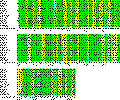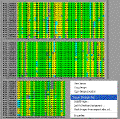BOXSHADE

BOXSHADE
presents the results of the alignment to show sequences which are identical,
similar or different.
The same proteins
from closely related species will be very similar to each other (such as
human and chimpanzee myoglobins). They will have the same amino acids
at most positions - these are said to be conserved.
The same proteins from two species which are not closely related will not
be similar to each other (such as human and whale myoglobins).
They will have different amino acids at many positions - the sequence is
not
conserved at these positions.
In some cases
where the same protein is being compared from many species (such as in
our present example) the amino acid present at a certain position in the
sequence may be the same for most species, but different
in a few. In this case, the amino acid sequence at this position
is neither "conserved" or "not conserved". Instead we speak of a
"consensus
sequence", which is the amino acid present
in most cases.
|

Click
on the thumbnail to see full-size! |
To
view the alignments in BOXSHADE:
Click on
the check box in front of "CLUSTAL W" to select the sequence alignment
to be shown in BOXSHADE.
Then select
"BOXSHADE";
Click
on the "Run" button. |
|

Click
on the thumbnail to see full-size! |
A
page entitled "BOXSHADE - Color-coded Plots
of Pre-Aligned Sequences" will appear.
It should show all of the sequences which were aligned by CLUSTAL W.
Scroll down
to find a selection box called "Residue Numbering". Set the "Residue
Numbering" box to "ruler". This will number each of the amino
acids (residues) from first to last.
Use the default
values in all the other boxes.
Click on
the "Submit" button. In order to change a setting use the "change
setting" button to return to the BOXSHADE page. |
|

Click
on the thumbnail to see full-size! |
The
output from BOXSHADE shows the alignment of myoglobin amino acid sequence
from each of the organisms. At the bottom the consensus
sequence is shown:
-
in caps at positions
where the amino acid is completely conserved;
-
in small letters
where it is not;
-
with a dash where
there is no consensus ( no conservation).
The bottom
line shows the numbering of the amino acids from 1 to 154.
A color scheme
is used to indicate which parts of the aligned proteins are similar, and
which are not:
 |
GREEN |
Single
fully conserved residues. That is, positions at which the amino acids are
identical
in all sequences. |
|
YELLOW and CYAN |
Consensus
is present. Identical residues are yellow; similar residues are cyan (for
example glu
and asp;
or leu
and ile). |
|
YELLOW and WHITE |
Consensus
is present. Identical residues are yellow; residues with no similarity
are white. |
|
CYAN and WHITE |
Consensus
is present. No strong identities. Similar residues are cyan; residues with
no similarity are white. |
|
CYAN |
Consensus
is present. No strong identities. Similar residues are cyan;. |
|
WHITE |
No conservation, identity or similarity. |
|
|
 |
|

Click
on the thumbnail to see full-size! |
To
save the output, move the mouse over the aligned sequence, right click
and select "save image as".
When
the dialog box appears, select the destination to save to, and name
the file. Click on "Save". The file will be saved as a gif
file which can be opened by any graphics application or browser.
To return to
the Biology Workbench Alignment Tools page, click on the "Return" button. |
|
|